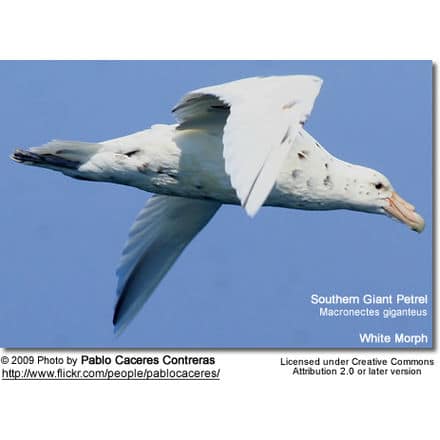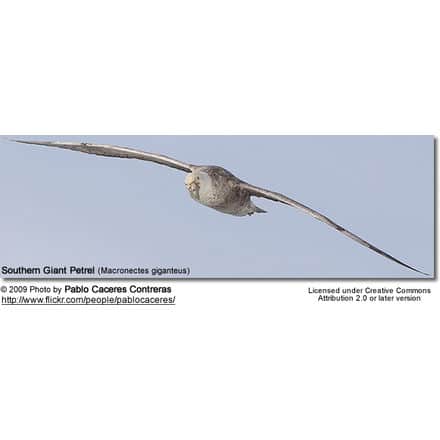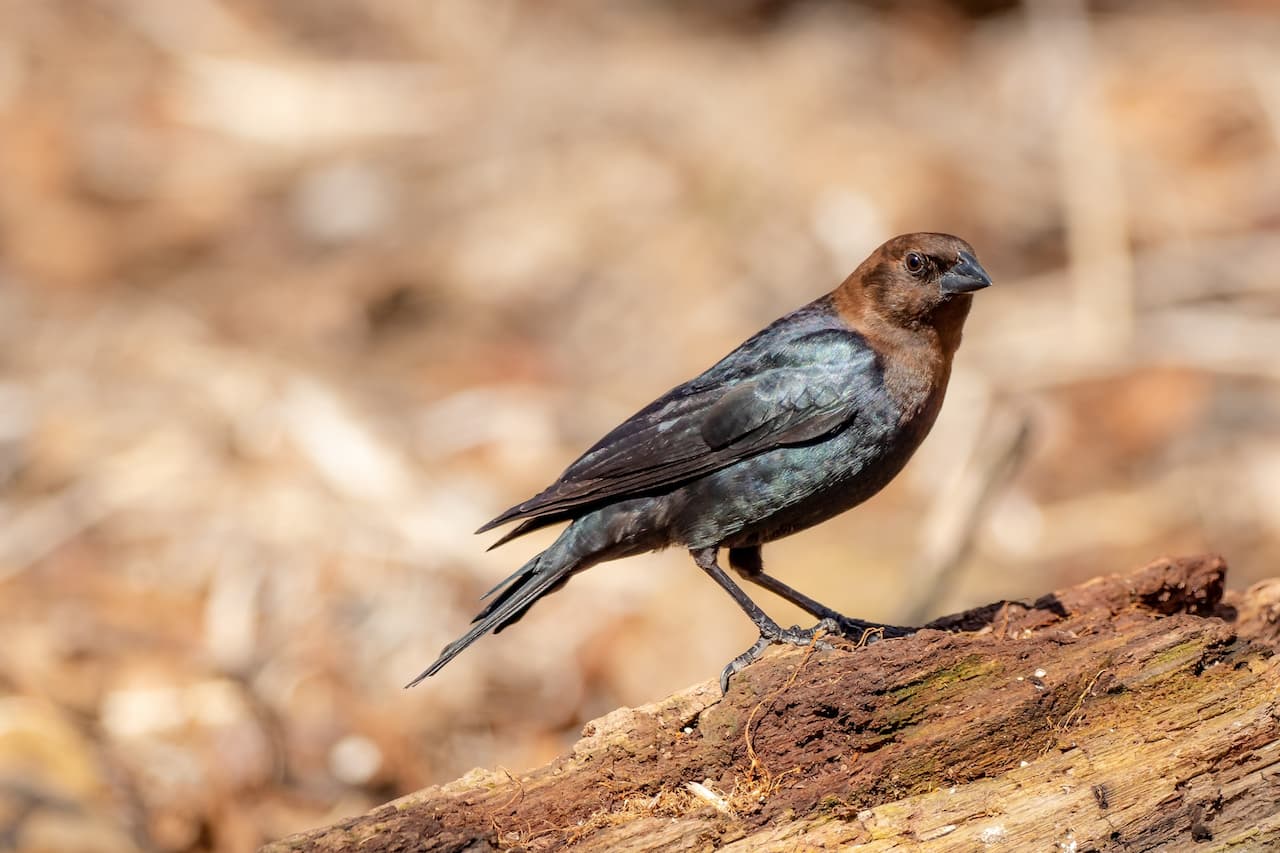Southern Giant Petrels or Antarctic Giant Petrel
The Southern Giant Petrels (Macronectes giganteus), also known as the Antarctic Giant Petrel, Giant Fulmar, Stinker, and Stinkpot, is a large seabird of the southern oceans. Its distribution overlaps broadly with the similar Northern Giant Petrel, though it overall is centered slightly further south.
Adults of the two species can be separated by the colour of their bill-tip: greenish in the Southern and reddish in the Northern.
They resemble seagulls and they have the ability of spitting a foul smelling concoction at predators.
Description
This petrel is the largest of the Precellariidae and measures 86–99 cm (34–39 in) with a wingspan of 185–205 cm (73–81 in). The male weighs approximately 5 kg (11 lb) and the female 3–8 kg (6.6–18 lb).
They have a very large yellow bill, with a green tip and greyish brown legs. There are two different morphs, the dark which resembles the Northern Giant Petrels, and the more distinct light morph (genetic mutation).
On the dark morph the upper breast, head and neack are light with the remainder of its plumage being mottled brown. The leading edge of its wing was lighter as are the base of the inner primaries, on the underside.
The light morph is rarer and very distinct with only slight black speckles on an otherwise all white look. As juveniles, the dark morph starts off more sooty brown and pales as it ages. Both Giant Petrels have legs that are stronger and thus can move around on land rather effectively. Finally, when in flight this species has a somewhat hunchbacked appearance.
It, like all members of the Procellariiformes have certain features that set them apart from other birds. First, they have nasal passages that attach to the upper bill called naricorns. Although the nostrils on the Petrels are on the top of the bill. The bills of all Procellariiformes are also unique in that they are split into between 7 and 9 horny plates.
Finally, they produce a stomach oil made up of wax esters and triglycerides that is stored in the proventriculus (stomach). This is used against predators as well as an energy rich food source for chicks and for the adults during their long flights. They also have a salt gland that is situated above the nasal passage and helps desalinate their bodies, due to the high amount of ocean water that they imbibe. It excretes a high saline solution from their nose.

Reproduction
The Southern Giant Petrels starts sexual maturity at six or seven years of age; however the average age of first breeding is ten years.
Its breeding season begins in October. Its nest is a mound of moss, grass, and stones with a depression in the center and located on bare or grassy ground.
They form loose colonies except in the Falkland Islands where the colonies are much larger.
One egg is laid and is incubated for 55—66 days. When the white chick is born it is brooded for two to three weeks and it fledges at 104—132 days.

Feeding
This Petrel will feed on krill, squid, and offal (= entrails and internal organs of butchered animals) in coastal and pelagic (over sea) waters, and unlike most other Procellariiformes, this bird will eat carrion (carcass of a dead animal) and even attack smaller seabirds.
The males exclude females from the carcasses that they are feeding off.
| Location | Population | Date | Trend |
| Falkland Islands | 19,500 pair | 2005 | Increasing |
| South Georgia | 5,500 pair | 2006 | Increasing |
| South Shetland | 5,400 pair | 2006 | Increasing |
| South Orkney Islands | 3,350 pair | 2006 | Increasing |
| Heard Island and MacDonald Island | 2,500 pair | 2005 | Decreasing |
| South America (Isla Noir, Diego Ramirez, Staten Island, Patagonia, islands off Chubut, Argentina) | 2,300 pair | 2006 | |
| Macquarie Island | 2,145 pair | 2005 | Decreasing |
| Prince Edward Islands | 1,800 pair | ||
| South Sandwich Islands | 1,550 pair | 2006 | Increasing |
| Antarctic Peninsula | 1,190 pair | Decreasing | |
| Crozet Islands | 1,060 pair | Increasing | |
| Antarctic Continent (Terre Adélie) | 280 pair | 2006 | Decreasing |
| Tristan da Cunha Islands | 230 pair | 2004 | Increasing |
| Kerguelen Islands | 4 pair | ||
| Gough Island | 1+ pair | Increasing | |
| Total | 97,000 | 2007 | Decreasing 1%—9% per 10 yr/Increasing now |
Range and habitat
The range of this bird is quite large as it ranges from Antarctica to the subtropics of Chile, Africa, and Australia, and has an occurrence range of 36,000,000 km2 (14,000,000 sq mi).
It breeds on numerous islands throughout the southern oceans.
The islands with larger populations include the Falkland Islands, South Georgia, South Orkney Islands, Staten Island, South Shetland, Heard Island, Macquarie Island, Prince Edward Islands, and Crozet Islands. The other locations with small populations are the Kerguelen Islands, Gough Island, Tristan da Cunha, Diego Ramirez, Isla Noir as well as four locations on the continent of Antarctica, including Terre Adélie, and small islands off the coast of Argentina near Chubut province. The colonies are visited year round.
Conservation
2009 was a good year for this species as it was upgraded to a status of Least Concern from Near Threatened, by the IUCN. This downgrade is not as optimistic as it sounds as it is not so much due to a recovering population, but a clearer picture and more accurate censuses.
Overall population trends show that in the 1980s there were 38,000 pair which dropped to 31,000 in the late 1990s followed by 46,800 presently. The Falkland Islands and most of the South Georgia Archipelago has shown increases from the 1980s to the present. Terre Adélie has shown a drastic reduction as the count fell to 10—15 pairs from 80 pairs in the 1980’s. The official 10/3 generation trend is listed by BirdLife International at a 1%—9% declinatation, but it is stated that this is a conservative number. They elaborate that a best case scenario puts it at a 17and increase and a worst case scenario of a 7.2% reduction.
Major threats to the well-being of this species start with the typical accidental deaths caused by longline fishing as well as trawl fishing near the Falkland Islands. Between 2,000 and 4,000 were killed in 1997—1998 due to illegal longline fishing. Also the numbers of Southern Elephant Seal, which is an important source of food as carrion (carcass of a dead animal), have been shrinking. Human disturbances have also adversely affected this bird.
To assist in this birds continued survival it was placed in CMS Appendix II (Bonn Convention) and Agreement on the Conservation of Albatrosses and Petrels (ACAP Annex I). Many of the islands that it breeds on are nature reserves, and Gough Island and Macquarie Island are World heritage sites. Monitoring is done on South Georgia, Marion Island, Crozet Islands, Terre Adélie, and Macquarie Island.Gough Island has had 2 censuses in the last decade.
Continued monitoring and surveys at major breeding sites have been proposed, as well as researching movement and migration. Finally continued promotion of “best-practice mitigation measures” via existing methods outlined in CCAMLR, Conservation Management System (CMS), and FAO.

Taxonomy
The Southern Giant Petrels is one of two members of the genus Macronectes, which in turn, along with 14 other genera, comprise the Procellariidae family.
Macronectes, also referred to as the Giant Petrels, along with the genus Fulmarus, Cape Petrel, Antarctic Petrel, and the Snow Petrel form a sub-family within the larger family.
The Southern Giant Petrels was first described as Macronectes giganteus by Johann Friedrich Gmelin, in 1789, based on a specimen from Staten Island off Tierra del Fuego.
Etymology
Macronectes giganteus can be broken down as makros a Greek word meaning long or large and nēktēs meaning swimmer, and giganteus from the Latin for gigantic.
Southern Giant Petrels starts with southern referring to their habitat being further south than their counterpart the Northern Giant Petrel, and Petrel refers to St. Peter and from the story of him walking on water, which refers to how they run on top of the water as they are getting airborne.
They were also called Fulmar, which comes from full a Old Norse word meaning foul, and mar meaning gull.







